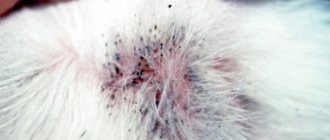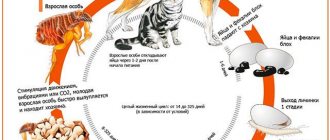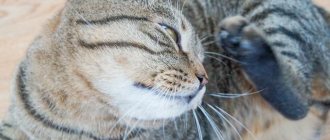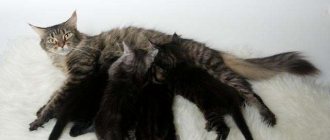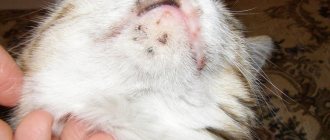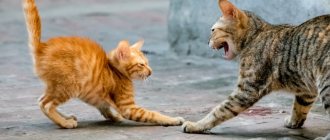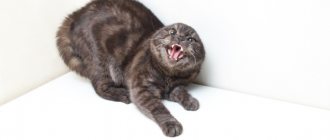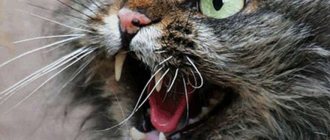The infestation of cats by fleas in cities and towns in Russia is usually seasonal and by the end of summer and autumn, up to 70% of cats are affected by this ectoparasite.
In nature, there are more than 100 species of fleas that infect our domestic animals, and some of them can attack humans.
Ctenocephalides felis (cat flea) is mainly found in cats. Simultaneously with cat fleas, cats can be attacked by fleas from dogs and rodents.
Morphology and development cycle.
Fleas are wingless insects. They have a bilaterally flattened body, covered with numerous spines and bristles, thanks to which fleas are held between the hairs of the cat's fur. The flea has six legs, the two back ones are more developed, thanks to which the flea has the ability to move in the cat’s hair at any angle and make long jumps, up to 1.5 meters. On the flea's abdomen there are special tactile hairs that are very sensitive to any air fluctuations. The chitinous cover protects the flea from any mechanical damage. Adults are brown in color, the size of the female is 2-2.3 mm, the size of the male is 2-2.5 mm. The mouthparts are piercing-sucking, simple eyes, epipharynx and antennae are located on the chitinous head. Adult fleas feed on the cat's blood. Sometimes they can feed on the blood of other animals. Blood enters the flea's stomach. Which has a volume of about 0.5µl, while at the same time, when sucking cat blood, the stomach can accommodate a blood volume 10-20 times larger. The flea's stomach is able to digest a small amount of blood consumed; most of the blood is released by the flea into the cat's hair in the form of small black feces. It has been noted that the flea has the ability to starve for several months. Upon external examination of flea-infested fur, we find a large amount of these feces, which look like poppy seeds.
The flea is an insect with a full development cycle. It has the stages of adult insect, egg, imago and pupa. The female flea lays her eggs wherever necessary, due to the absence of a sticky mass on its surface, from which after about 2 weeks a worm-like larva appears, which begins to grow, molting several times. Indoors, the larvae live in dust and debris, feeding on decaying organic matter and excrement. Later, the larva pupates and after some time an adult insect emerges from the pupa. The insect's lifespan is approximately 2 years. Parasites reproduce very actively; during her life, a female flea can lay up to 2 thousand eggs.
Pathogenesis. When fleas come into contact with a cat, they bite through the epidermis and begin to suck blood from the bitten capillaries. As a result of a massive flea infestation, a cat may develop multiple bites on its skin within a few minutes. The cat develops an allergic reaction to antigens that are present in the flea’s saliva and are introduced into the cat’s skin through bites, and allergic dermatitis appears. As a result of a flea bite with its infected blood, feline infectious anemia (hemobartonellosis), in which red blood cells are damaged, can be transmitted to a cat through a damaged membrane. It has been established that fleas contribute to the infection of cats with invasive diseases. In particularly sensitive cats, prolonged itching can develop even with a small number of fleas parasitizing the cat. As a result of constant itching, papules, scabs and bald patches appear on the cat's skin.
Clinical picture. A cat affected by fleas is accompanied by the presence of severely itchy areas on the body, and the cat not only constantly itches, but bites into the bite site with its teeth. As a result of constant scratching, the hair falls out in certain areas of the body (the neck area is most often affected), and the combed skin becomes covered with reddish crusts. Constant itching makes the cat nervous. During a clinical examination, the veterinarian finds flat miniature dots attached to the skin in the hair, similar in appearance to millet grains. Having drunk blood, fleas begin to move actively, and in some cases, jump. Using a magnifying glass, you can notice a dark brown, flat, elongated body measuring 2 or 3 mm, no wings, and long, jumping hind legs. In the depths of the fur near the skin, upon careful examination, a specialist finds waste products of fleas - dark-colored, fine-grained excrement. At the same time, upon careful examination, you can find flea eggs, which, unlike excrement, are oval in shape, larger and white in color.
In cats, as a result of flea infestation, complications often occur in the form of pyotraumatic dermatitis. With severe flea infestation, anemia is recorded as a result of a decrease in the amount of blood. Sometimes we note symptoms of lymphadenopathy and eosinophilia.
Unlike lice and lice eaters (which are parasitic bloodsuckers), fleas have great jumping ability when viewed, jumping up to a height of half a meter, and can move along the cat’s body, covering as much as 30 cm in one jump. While the louse crawls over its victim.
The diagnosis of a cat being affected by fleas is made based on the collected history, clinical picture of the disease, season and, of course, on the basis of the detection of fleas or flea feces. When making a diagnosis, you can resort to thorough combing of the fur with a thick comb. Place the particles combed out of the hair onto moistened filter paper. After a few minutes, a red zone appears around the combed out grains - representing flea feces with excess blood. The presence of a red zone is considered to be a diagnostic sign of a cat being affected by fleas, even if no living fleas are found. The disease is accompanied by the presence of eosinophilia in the cat.
Differential diagnosis. When conducting a differential diagnosis, veterinary specialists must exclude the presence of other ectoparasites (ticks, lice), dermatophytoses (ringworm, etc.), folliculitis, dietary disorders (lack of biotin, essential fatty acids), and food allergies in the cat.
Fleas in cats: morphology and development cycle
The cat flea is one of the parasites of animals that can also attack humans. She looks like a tiny dark insect without wings. Body size: 0.5–5 millimeters. However, a female engorged with blood can swell up to 16 millimeters.
Fleas parasitize cats and rats. When attacking a person, it selects the area of the legs below the knee.
The lifespan of a flea depends on living conditions and usually ranges from 3 months to 1.5 years.
Favorable conditions for fleas
| Temperature | 20–25 ºС |
| Air humidity | 60 % |
| Humidity | 70 % |
Fleas breed all year round. One female is capable of laying from 2 to 15 eggs at a time. Thus, an individual can reproduce about 500 throughout its life.
Important! This number is arbitrary, since for the eggs to fully mature, the female needs to fully feed on blood.
Places for laying can be different: cracks in the floor or walls, bedspreads or animal beds, food waste, soil, pet hair.
Stages of flea development:
- Egg. A tiny white dot. Size: 0.5 millimeters. Cycle: from 2 days to 2 weeks.
- Larva. Resembles a worm with segmented hairs. Size: about 5 millimeters. It is mobile, growing by eating feces, blood or plant waste. Cycle: from 9 days to 8 months.
- Doll. Looks like a larva in a cocoon. Cycle: from 6 days to 1 year.
- Imago. Is a full-fledged adult.
How do fleas appear on a cat?
The appearance of fleas in cats can be caused by a number of reasons:
- The animal loves to explore the entrances and basements of the house. After all, rooms without ventilation with the same level of humidity and a minimum of light are ideal conditions for the reproduction of fleas.
- Penetration of insects from neighboring apartments. Fleas can move through the thinnest cracks, so there is only one way to protect yourself from uninvited guests after getting rid of them - to make high-quality repairs.
- Contact with an infected cat – even minimal animal contact is enough.
- Carrying fleas on clothes. Unfortunately, the owner can infect the animal on his own, and in this case it is impossible to protect himself from undesirable consequences.
- Inadequate cleaning after treatment of the cat. Simply washing the floors and bowls is not enough: eggs or larvae may remain in furniture, carpets or the animal's bed. If fleas appear in the house again, repeated treatment and better cleaning of the premises is required.
Prevention
- treating your pet with anti-flea agents, wearing a collar;
- extermination of parasites in the house and surrounding area.
In addition to treating the animal itself, pay attention to treating the apartment:
- Vacuum the room regularly, paying attention to hard-to-reach places (corners, baseboards, space under furniture);
- in parallel, use anti-flea agents to treat premises, for example, methoprene or pyriproxyfen;
You can also prevent the disease by observing the following rules:
- avoid contact with street cats;
- regularly treat household items (bedding, toilet, houses, beds) with boiling water;
Scratching bite sites
How dangerous are fleas on a cat?
In cats, fleas can cause both minor health problems and very serious problems. In the first case, the animal is bothered by itching, so it begins to actively scratch: wounds and abrasions appear.
If the owner rids the cat of fleas immediately, there will not be much damage to health. However, in advanced cases, dermatitis may develop. In addition, cats tend to bite and swallow fleas, which is dangerous due to intoxication, helminth infection and even anemia.
Flea allergic dermatitis
Dermatitis in cats is provoked by flea bites and subsequent active scratching. Animals that are prone to allergies are at risk.
Flea saliva consists of complex compounds that are not dangerous in small doses. But if a cat is repeatedly bitten, it may develop hypersensitivity.
Signs of flea dermatitis:
- itching;
- redness;
- scratches, open wounds;
- hair loss.
The disease progresses quickly, so it is important to start treatment as soon as possible. You can also deal with fleas at home. The main thing is an integrated approach.
Important! Flea dermatitis is dangerous due to complications that will inevitably arise in the presence of open wounds. After all, they are a natural environment for bacteria. If an unpleasant odor begins to emanate from the animal, this is a sure sign that the wound has a yeast or bacterial infection.
Anemia in kittens
Anemia is a pathology in which there is a simultaneous drop in the level of red blood cells and hemoglobin in the blood. It can develop in an adult animal. However, it is most dangerous for a kitten’s fragile body due to the likelihood of death.
Anemia can be caused by various reasons. One of them is flea infestation.
Signs of anemia in a kitten:
- weakness;
- pallor/cyanotic/yellowishness of the mucous membrane;
- refusal to eat;
- weight loss;
- dyspnea.
Anemia is a serious disease. It cannot be cured by simply getting rid of the original source, which is cat fleas. Therapy includes taking various medications that are aimed at restoring normal blood composition. And only a veterinarian can prescribe them.
Infectious and parasitic danger of fleas: hemobartonellosis and dipilidia
Hemobartonellosis is an infectious anemia. It is provoked by microorganisms carried by fleas and mosquitoes. Unlike classical anemia, a malfunction of the body occurs due to the fact that microbes directly destroy red blood cells.
The disease is dangerous because it occurs secretly. Symptoms may not appear for up to 5 months after infection.
Signs of hemobartonellosis:
- decreased activity;
- loss of appetite;
- weight loss;
- pallor of the mucous membrane;
- heat;
- enlarged spleen.
Important! Hemobartonellosis requires complex treatment, which may include blood transfusions. And even if the cat recovers, liver or kidney failure may persist.
Dipilidiosis is a disease caused by the cucumber tapeworm. The parasite is white-gray or pink in color. It can reach 70 cm in length and 3 mm in width. A cat can become infected with dipilidia by eating adult fleas - they are the carriers of the pathogen larvae.
Signs of infection:
- weight loss;
- changes in eating behavior;
- The cat is constantly nervous.
Important! Dipylidiasis is also dangerous for humans.
Harm to humans
The damage caused by ectoparasites to people is as follows:
- Bites.
- Transmission of contagious diseases.
Bites
A flea bite is regarded by the body as an irritant:
- A rash appears.
- Scratching appears, fraught with the development of suppuration.
- Dermatitis occurs, which can transform into pyoderma.
- Superficial lymph nodes become hypertrophied.
- Insomnia, migraine, diarrhea, and difficulty breathing develop.
Fleas are stuck
Transmission of contagious diseases
Cat fleas transmit the following infectious diseases to humans:
- Anthrax.
- Tifa.
- Encephalitis.
- Brucellosis.
- Worms.
Symptoms of flea infestation
It is difficult to detect fleas at the initial stage. However, this is quite possible if you examine the cat’s stomach. It is in this area that, upon careful examination, insects or their feces can be seen.
Signs of flea infestation:
- active scratching;
- the cat is worried, reacts sharply to stimuli, meows;
- loss of appetite;
- weakness, reluctance to play.
If you do not get rid of fleas on a cat in time, the animal will begin to lose weight, and ulcers will begin to form at the bite sites. In addition, advanced infestation is associated with the presence of bald spots in the fur.
Diagnostics: how to determine that a cat has fleas?
Before you start fighting fleas, you need to make sure that it is they that are bothering your cat:
- It is necessary to pay attention to where exactly the cat is itching. Fleas are active on the sides and back (or on the whole body if the infestation is advanced), and ticks are active behind the ears and in the groin.
- Flea eggs and feces in a cat. If white and black dots are observed on the skin and at the base of the hair, it means that there are adult fleas on the animal.
- Skin irritation. Ulcers, scratches, and redness are typical signs of an advanced flea infestation.
- Detection of fleas by visual inspection. It’s easy to understand that it’s a flea in front of you. It has a rounded body 0.5 millimeters long and very thin long legs. You can find insects if you simply move the fur in different directions. In addition, fleas will begin to jump off the cat while bathing - no other insect can do this.
Consequences of allergies
Severe itching of the skin, which occurs in response to flea saliva, causes the cat to actively itch and bite the skin with its teeth. This leads to mechanical damage to the epidermis and the appearance of open wounds. As a result, a favorable environment for secondary infection is created. Infection aggravates the course of the allergy and can lead to the formation of large inflammatory areas in which pus accumulates.
The resulting wounds contain pathogenic fungi and bacteria, which are not at all easy to deal with.
Allergies also have an extremely negative effect on the animal’s immune system. Suppressed immunity reduces the body's resistance to various viruses and infections. The cat's general condition and behavior are only getting worse.
In addition, allergies can trigger the development of Quincke's edema. This is a complex pathological condition that can lead to the death of an animal due to suffocation.
What to do if your cat has fleas: treatment methods and review of remedies
You can remove fleas from a cat using different means. They come in different forms:
- drops;
- shampoos;
- sprays;
- collars;
- pills.
In addition to common sprays, shampoos, and tablets, there are even ultrasonic repellers that hang as a keychain on an animal’s collar. However, not all of them are effective.
Most flea remedies have a prolonged action, that is, the effect lasts for a long time (1-6 months).
Before you start removing fleas, it is important to consider a number of points:
- age of the cat;
- whether the pet is sick (a weakened animal cannot be treated with chemicals);
- tendency to allergies to the components of the drug.
For kittens, pregnant and lactating cats, you will need to buy specialized products.
Fleas on a cat - drops
As a rule, drops require a single use. Depending on their composition, they have a destructive or repellent effect. Products containing insecticides are the most effective, but they must be used strictly according to the instructions (the dosage is calculated based on the weight of the cat). Drops with essential oils are not so toxic, so they are suitable for weakened animals, but in case of advanced infestation they will not be able to help.
List of effective drops:
- Advantage.
- Leopard.
- Advocate.
- Frontline Combo.
- Stronghold.
The advantages of drops include speed (fleas die in 1–2 days), as well as versatility (many drugs simultaneously fight lice, lice and ticks). Disadvantages - the need to prevent the cat from coming into contact with water and small children. In addition, many drops are not suitable for newborn kittens or pregnant or lactating cats.
Important! As a rule, the drops are valid for 3 months. After this period, the animal will need to be processed again.
Fleas on a cat - shampoos
Shampoos kill fleas if you wash your cat once, but do not have a delayed effect. Like drops, depending on the composition, they either repel fleas or destroy them.
List of effective shampoos:
- Outpost.
- Beaphar.
- Mr. Bruno.
- Mr. Kiss.
- Rolf Club.
The advantage of shampoos is that they can be used not only for their intended purpose, but also to wash rugs from beds or wash toys. They are suitable for kittens and pregnant and lactating cats, as long as they do not contain insecticides.
Disadvantages of shampoos: the fragility of the effect and the risk of poisoning the animal if the product is not thoroughly washed off the fur.
Sprays
Using a spray you can remove not only fleas, but also their larvae and eggs. In addition, products of this kind are effective against lice, ticks and lice-eaters.
When choosing a drug, it is worth considering that they come in 2 types:
- for processing animals;
- for processing the room.
List of effective sprays:
- Leopard.
- Celandine.
- Frontline.
- Hartz.
- FitoDoc AB3.
Sprays can kill fleas in a single application, even with an advanced infestation. However, this effectiveness is explained by strong toxicity - if used incorrectly, they can harm the animal and provoke allergies. Although there are drugs that are suitable for 2-day-old kittens, for example Frontline.
Important! Sprays are used strictly according to the instructions. It is not enough to simply treat the animal in a ventilated area. You need to put on your work clothes and then wash them thoroughly. You should also make sure that the drug does not get into your pet’s eyes.
Collars
Collars are also used to kill fleas or repel them. In the first case, the tape is impregnated with insecticides, in the second - with vegetable and essential oils. These points should be taken into account if the animal is still small or is bearing offspring.
Adult cats and kittens over 3 months of age can wear insecticide collars. For kittens, pregnant and lactating cats - with esters.
List of effective tapes:
- Leopard.
- Doctor Zoo.
- Celandine.
- Beaphar.
- Hartz.
Collars last a long time - up to 6 months. There are also models with complex action: against fleas, lice, ticks and lice at the same time. They are not as toxic as sprays, but are not able to cope with insects if the infestation has reached a critical stage. In this case, it is better to apply drops or spray, and then apply tape to the already treated cat.
The key to the effectiveness of the collar is proper wearing. The tape should not fit tightly. A finger should fit freely between the collar and the animal's neck. It is also important to cut off any excess tape that remains after the fastener is attached. The cat may bite it, which will cause poisoning.
Interesting! Manufacturers have long moved away from the monotonous production of black collars. Nowadays you can find ribbons in a variety of colors on the shelves. Now, in addition to protection against fleas, there is also an aesthetic point: you can choose a collar that matches the color of a particular cat.
Pills
Tablets stand apart among flea control products. This is a last resort when the animal is in a neglected state. External preparations are not suitable if the cat has dermatitis and other skin lesions. It is in such cases that it is necessary to resort to tablets.
However, treatment at home cannot be done without consulting a specialist. It should be understood that an animal with a serious infestation requires the help of a veterinarian. The list of drugs in tablet form is quite wide.
There are products for one-time use, and there are those that are taken in a course. There are drugs only against fleas, and there are drugs against fleas and ticks at the same time. Therefore, only a veterinarian can choose the right remedy after examining the animal.
List of known tablets:
- Comfortis.
- Bravekta.
- NexGard.
Important! Manufacturers produce dog flea tablets. They should not be given to cats, even if we are talking about drugs for small breed dogs. Many medications that are intended for canines depress the cat's nervous system.
Home disinfection
After treating a cat, an important step in the fight against fleas is treating the home.
Professional disinfection
Professional disinfection is the most effective. A team of specialists will arrive at your home, assess the sanitary condition of the home and choose the most appropriate disinfection method. Typically, disinfection is carried out either using a heat gun or using chemicals. The owner is only required to prepare the house and pay for the services.
Important! A few days after professional treatment, you may find fleas on the floor. However, do not think that the service was provided poorly. Insects could easily remain in the cracks and gaps, but upon contact with the treated surface they quickly die. A similar phenomenon can be observed within 5 weeks after the visit of specialists.
Disinfect yourself
You can disinfect your home yourself using a spray or powder.
Processing stages:
- Remove children, animals and indoor plants from the house.
- To throw out the trash.
- Move furniture away from the walls. Remove from the walls all objects that hang on them.
- Put on work clothes.
- Spray the entire home, including carpets, upholstered furniture, clothing, shoes and bedding. Particular attention should be paid to the animal's belongings.
- Close doors and windows. Leave the house for several hours, ideally all night.
- Upon return, ventilate the rooms well, wash all surfaces and wash all items that have been processed.
Unlike sprays, powders are less effective, but when using them you do not need to leave your home. It is enough to scatter the granules in places where fleas are most concentrated (cracks, areas behind the baseboard). Upon contact with the granular substance, not only adult individuals die, but also their larvae and eggs.
Treatment
Your veterinarian will prescribe medications to treat flea dermatitis. The treatment regimen is as follows:
- relieving acute itching using antihistamines based on glucocorticosteroids;
- antiparasitic treatment, including the destruction of fleas and the use of preventive agents;
- treatment of secondary purulent infection with antibacterial agents.
The main requirement for treating cats is regularity. You should not take breaks in the use of antiparasitic drugs, as this may cause the disease to become chronic. When using antibiotics, it is unacceptable to complete the course before the time specified by the veterinarian in order to avoid the development of drug resistance.
How to remove fleas from a cat at home using folk remedies: myths and reality
Myth #1: Wormwood repels fleas. This is certainly true. You can pick up several armfuls and place them in different corners of the house. There will be fewer fleas, but the effect will only last until the plant dries out. In addition, the smell of wormwood is specific even to humans. So there is a risk of not only fleas leaving the house, but also guests and household members.
Myth No. 2: Essential oils will save you from fleas. Peppermint, pine, eucalyptus and lavender are safe for cats. As a rule, you can find advice on the Internet that says that you need to dilute a few drops in a glass of water and treat the animal with the resulting solution. Next, the oil concentrate is dripped onto sponges or napkins, which are laid out in different places in the house. However, it is worth considering here that essential oils do not kill insects, but only repel them. So there can be no talk of complete deliverance. In addition, odors disappear quickly: the animal will need to be treated daily, as will the napkins.
Myth #3: Let there be salt and soda. The saline or soda solution is safe for kittens and pregnant and lactating cats. It is prepared like this: 100 grams of the substance are diluted in 1 liter of warm water. It is used according to the following scheme: the animal must be kept in the resulting solution for 10–15 minutes, after which it is washed with baby soap, dried and combed. You can also wash the floors in your apartment with this solution and wash your pet’s bed. However, there are controversial points here too. You can’t keep the whole animal in the solution: the head will still be above the water, which means insects may well run across it. Washing a room with salt is associated with stains, so washing and re-washing is still necessary afterwards. And such solutions are effective only for 3-4 days, and then require repeated use.
Which method of fighting fleas deserves attention is determined by everyone for themselves. However, it is worth understanding that traditional methods either simply repel insects or act for an extremely short time. Therefore, you can resort to them only if the animal is allergic and categorically cannot tolerate the effects of chemicals. However, after this, it is advisable to temporarily transfer the pet to friends and disinfect the home with chemicals.
